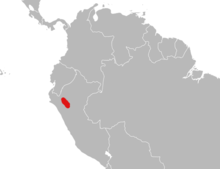Eremoryzomys polius
| Eremoryzomys polius | |
|---|---|
| Scientific classification | |
| Kingdom: | Animalia |
| Phylum: | Chordata |
| Class: | Mammalia |
| Order: | Rodentia |
| Family: | Cricetidae |
| Genus: |
Eremoryzomys Weksler, Percequillo, and Voss, 2006 |
| Species: | E. polius |
| Binomial name | |
|
Eremoryzomys polius (Osgood, 1913) |
|
 |
|
| Range in northern Peru | |
| Synonyms | |
|
|
Eremoryzomys polius, also known as the gray rice rat or the Marañon oryzomys, is a rodent species in the tribe Oryzomyini of the family Cricetidae. Discovered in 1912 and first described in 1913 by Wilfred Osgood, it was originally placed in Oryzomys and named Oryzomys polius. In 2006, a cladistic analysis found that it was not closely related to Oryzomys in the strict sense or to any other oryzomyine then known, so that it is now placed in its own genus, Eremoryzomys. The Brazilian genus Drymoreomys, named in 2011, is probably the closest relative of Eremoryzomys. Eremoryzomys has a limited distribution in the dry upper valley of the Marañón River in central Peru, but may yet contain more than one species.
A large, long-tailed rice rat, with head and body length of 138 to 164 mm (5.4 to 6.5 in), E. polius has gray fur and short ears. There are well-developed ungual tufts of hair on the hindfeet. Females have eight mammae. The rostrum (front part of the skull) is long and robust and the braincase is rounded. The bony palate is relatively short. The IUCN assesses the conservation status of the species as "Data Deficient"; it is poorly known but may be threatened by habitat destruction.
The first two specimens of Eremoryzomys polius were collected by Wilfred Osgood and M.P. Anderson in 1912. The next year, Osgood described these animals as a new species in the genus Oryzomys, Oryzomys polius. Osgood wrote that he was unable to find any species closely related to O. polius and compared it with O. xanthaeolus (currently Aegialomys xanthaeolus) "for convenience". Its relationships remained obscure ever afterward and it was never assigned to any of the several groups of species recognized within Oryzomys.
...
Wikipedia

